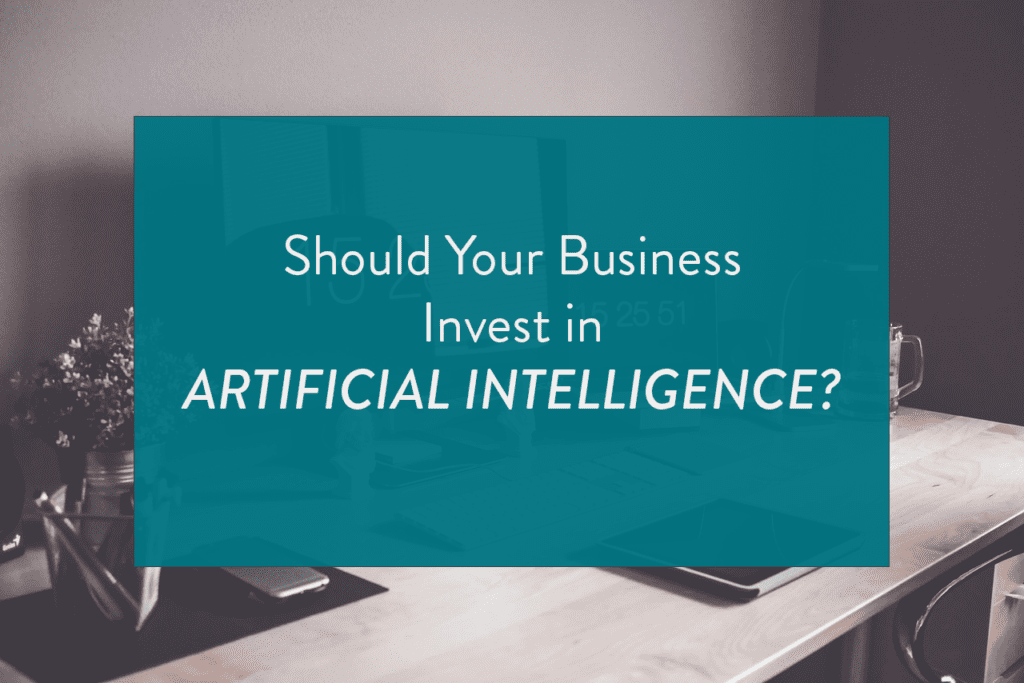Invest in AI Want to start implementing AI into your business but you’re not sure how much it’s going to cost? One of the main reasons why businesses fail to implement AI into their company is because they think it will be too expensive. So, how much does it cost to add AI into the business?
Here is a rough guide on how much you should invest in AI technology to receive the biggest benefits.
How Much Does AI Cost?

You have two options when you’re looking to implement AI technology into your business. You can either invest in third-party AI software, or you can have a custom AI solution developed specifically for your business. The cost between these two options can vary drastically.
With third-party software, it can cost anywhere from $0.00 to $40,000 a year to have it implemented into your business. If you go for a custom-made solution, however, you could be looking at anything from $6,000 to $300,000 per year. So, how much you can expect to pay will depend upon your needs.
You may even find free AI solutions which could prove beneficial. However, these tend to be mostly aimed at start-ups and entrepreneurs. The more you’re willing to spend, the more benefits the business will receive.
Factors That Affect the Price Invest in AI
There are a lot of things that can affect the price of AI technology. The type of technology, its features and whether it is a pre-made or custom-built solution will all influence the cost.
There are so many different types of AI solutions out there. You can implement chatbots, virtual assistants and analysis systems into the business. The more features the AI technology has, the more expensive it’s going to be. As mentioned, the very basic AI programs are often offered for free. However, an intelligent and comprehensive system is going to set you back thousands of dollars.
Once you have the AI technology, the costs don’t stop there. How you launch and manage the solution can also affect the cost. You may need to hire an in-house team, for example, or outsource your AI technology needs.
These are the main factors that will influence the price of AI technology. The truth is, no matter what your budget, you’ll be able to find an AI solution to match it.
In-House vs Outsourcing AI Technology Invest in AI

Your main options when introducing AI technology into the business is to have an in-house team or to outsource its maintenance. Both have their pros and cons. However, outsourcing tends to be better for those new to the technology, along with start-ups.
By outsourcing your AI requirements
it’s cheaper and a lot less hassle. An expert in AI will be able to implement and run it for you. This is a much easier solution for start-up businesses.
Overall, how much you should invest in AI technology will depend upon your requirements. It’s worth sitting down and assessing your needs to ensure you don’t pay for a solution that’s too advanced or complex for your business.
Artificial intelligence (AI) is a rapidly growing field with the potential to revolutionize many industries. There are many reasons to invest in AI, including:
- The growth potential of the AI market: The global AI market is expected to reach $1.2 trillion by 2025. This growth is being driven by the increasing demand for AI-powered products and services.
growth potential of the AI market
- The increasing demand for AI-powered products and services: AI is being used to power a wide range of products and services, including self-driving cars, virtual assistants, and fraud detection software. The demand for these products and services is growing rapidly, and this is creating opportunities for businesses to invest in AI.
increasing demand for AI-powered products and services
- The potential for AI to disrupt traditional industries: AI has the potential to disrupt many traditional industries, such as healthcare, manufacturing, and transportation. By automating tasks and making decisions more efficiently, AI can help businesses to improve their operations and reduce costs.
potential for AI to disrupt traditional industries
In addition to these benefits, there are a number of other reasons to invest in AI. For example, AI can help businesses to:
- Improve customer service: AI can be used to create chatbots that can answer customer questions and resolve issues 24/7. This can help businesses to improve customer satisfaction and reduce costs.
- Increase productivity: AI can be used to automate tasks, such as data entry and customer service. This can free up employees to focus on more strategic tasks, which can lead to increased productivity.
- Make better decisions: AI can be used to analyze data and make predictions. This can help businesses to make better decisions about things like marketing, product development, and pricing.
Overall, there are many reasons to invest in AI. The field is growing rapidly, there is a high demand for AI-powered products and services, and AI has the potential to disrupt many traditional industries. By investing in AI, businesses can improve their operations, reduce costs, and make better decisions.
Here are some specific examples of how AI is being used to disrupt traditional industries:
- Healthcare: AI is being used to develop new drugs and treatments, to diagnose diseases, and to provide personalized care. For example, IBM’s Watson Health platform is used by hospitals and healthcare providers to diagnose cancer and other diseases.
Healthcare
- Manufacturing: AI is being used to automate tasks, such as quality control and predictive maintenance. For example, General Electric’s Predix platform uses AI to predict when machines are likely to fail, so that they can be repaired before they break down.
Manufacturing
- Transportation: AI is being used to develop self-driving cars, to optimize traffic flow, and to improve freight transportation. For example, Waymo’s self-driving cars have already logged millions of miles on public roads.
Transportation
There are a number of ways to invest in AI. Some of the most common methods include:
- Investing in individual AI companies: This is the most direct way to invest in AI. However, it can also be the most risky, as individual companies may not be successful.
- Investing in AI ETFs: ETFs are a type of investment fund that tracks a basket of stocks or other assets. There are a number of AI ETFs available, which can provide a more diversified way to invest in AI.
- Investing in AI-related industries: This is a less direct way to invest in AI, but it can be less risky. For example, you could invest in the semiconductor industry, which supplies the chips that power AI systems.
Here are some specific examples of AI ETFs:
- ARK Innovation ETF (ARKK): ARKK is a popular ETF that invests in disruptive technology companies, including AI.
ARK Innovation ETF (ARKK)
- iShares Exponential Technologies ETF (XT): XT is an ETF that invests in companies that are developing new technologies, including AI.
iShares Exponential Technologies ETF (XT)
- Global X Robotics and Artificial Intelligence ETF (BOTZ): BOTZ is an ETF that invests in companies that are developing robotics and AI technologies.
Global X Robotics and Artificial Intelligence ETF (BOTZ)
Here are some specific examples of AI-related industries:
- Semiconductors: The semiconductor industry supplies the chips that power AI systems. As AI becomes more widespread, the demand for semiconductors is likely to increase.
Semiconductors
- Software: The software industry is developing new AI-powered software applications, such as chatbots, facial recognition software, and fraud detection software.
Software
- Hardware: The hardware industry is developing new AI-powered hardware devices, such as self-driving cars, virtual assistants, and drones.
These are just a few examples of the different ways to invest in AI. The best way to invest in AI will depend on your individual investment goals and risk tolerance.
Here are some tips for investing in AI:
- Do your research: Before you invest in any AI company or ETF, it is important to do your research and understand the risks involved.
- Invest for the long term: AI is a long-term investment. It is important to be patient and not expect to get rich quick.
- Diversify your portfolio: Don’t put all your eggs in one basket. By diversifying your portfolio, you can reduce your risk.
- Rebalance your portfolio regularly: As your investment goals and risk tolerance change, you should rebalance your portfolio to ensure that it still meets your needs.
-
There are a number of risks associated with investing in AI. Some of the most common risks include:
- High volatility: The AI market is still in its early stages, and it is highly volatile. This means that the prices of AI stocks and ETFs can fluctuate wildly, which can make it difficult to make money.
- Lack of regulation: The AI industry is largely unregulated. This means that there are no rules or regulations governing the development and use of AI. This could lead to the misuse of AI, which could have negative consequences for society.
- Potential for misuse: AI could be misused for malicious purposes, such as creating autonomous weapons or spreading disinformation. This is a serious risk that needs to be carefully considered before investing in AI.
Here are some other risks of investing in AI:
- Technical risks: AI is a complex technology, and there are risks associated with the development and deployment of AI systems. For example, AI systems could be hacked or could malfunction, which could lead to financial losses or other problems.
- Economic risks: The AI market is still in its early stages, and it is not clear how large the market will be in the future. This could lead to economic losses for investors if the market does not grow as expected.
- Social risks: The development and use of AI could have negative social consequences, such as job losses or increased inequality. This is a risk that needs to be carefully considered before investing in AI.
Overall, there are a number of risks associated with investing in AI. It is important to do your research and understand these risks before you invest.
Here are some tips for mitigating the risks of investing in AI:
- Do your research: Before you invest in any AI company or ETF, it is important to do your research and understand the risks involved.Invest in AI
- Invest for the long term: AI is a long-term investment. It is important to be patient and not expect to get rich quick.Invest in AI
- Diversify your portfolio: Don’t put all your eggs in one basket. By diversifying your portfolio, you can reduce your risk.Invest in AI
- Rebalance your portfolio regularly: As your investment goals and risk tolerance change, you should rebalance your portfolio to ensure that it still meets your needs.Invest in AI
By following these tips, you can help to mitigate the risks of investing in AI and make sure that your investment is as safe as possible.Invest in AI
